Acoustic Zen Absolute Cables
| Acoustic Zen Absolute Cables |
| Absolutely! |
|
|
|
November 2007 |
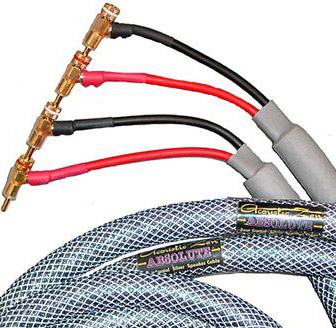
Over the course of the last few months I’ve grown accustomed to receiving a message from my assistant, Beverly Turner, that a package from California has arrived. Not that this is anything out of the ordinary – I often receive packages from the “Golden State” – but I’m usually not that excited about the contents. Generally it’s extensive reading material that I need for work, and far less entertaining than reading the latest two-channel stereo equipment reviews on say, The Stereotimes. But this time when Beverly informed me that the box, which was from San Diego, had arrived and was lighter than usual (paper weighs a lot you know), I immediately suspected that this might be the box containing something that I was eagerly anticipating; the Acoustic Zen Absolute loudspeaker cables. I had already received the Absolute power cords and Absolute interconnects. The loudspeaker cables were the final pieces I needed to complete the review of the Absolute line. After taking a quick glance at the shipping label I realized that my suspicions were correct and I eagerly awaited the day’s end when I could go home and insert them into my system.
The Absolute series is comprised of Robert Lee’s top of the line cables. Each Absolute cable is hand built by Mr. Lee, and in between building the tweeters for his very popular Adagio and newly released Adagio Jr. loudspeakers, he finally found the time to make me up a set of speaker cables. The Absolutes are made from zero crystal continuous cast copper and/or zero crystal continuous cast silver just like his other lines. Zero crystal copper and zero crystal silver are metals that according to Mr. Lee, “are relatively free from any harmful crystals that might affect the sound in a negative way.” Any kind of contaminants or crystalline structure, even if slight, can cause some degradation in performance. This is not a good thing when you’re transmitting audio signals.
To protect the Absolute cables from getting damaged during shipment, each set of cables is delivered to the customer in a handsome sturdy silver aluminum case with an internal foam lining. With an average price of $2,488 for a one meter pair of the interconnects, $2,488 for a six foot power cord, and $2,880 for an eight foot pair of the speaker cables, it’s important to make sure that they arrive at their destination in pristine condition.
Regardless of how handsome some cables may be on the outside, some nasty anomalies can take place on the inside. To reduce the negative effects of capacitance, resistance, and inductance, Mr. Lee uses a technique that he refers to as “constant air twisting” in which he takes a group of conductors and twists them around hollow, air-filled Teflon tubes which, Lee says are “supposed to have superior dielectric properties.”
Teflon is a common material that is used as the backbone in other cable designs, but each of the Absolutes cables are made with special lightweight foam Teflon instead of regular Teflon. This type of Teflon is much more flexible than regular Teflon and has a better dielectric constant and is also a lot more expensive to produce. He further shields them by using copper foil and braided material to minimize RFI and EMI and then packages them in a nice regular Teflon jacket with interlacing reflective fibers that allows the cables to glow in the dark when hit with a beam of light.
The Power Providers
When I initially compared the Absolute power AC cords to the Gargantua IIs, I wasn’t really sure if Acoustic Zen didn’t make a mistake when they shipped me the Absolute cables. The diameters and the weight of the two cables are very similar and to make things even harder to distinguish between the two designs, Mr. Lee uses the same high-quality male and female IEC connectors on both the Absolute and Gargantua II power AC cords. The only noticeable physical difference is the decorative silver fibers that he uses on the outside of the Absolutes as opposed to the gold threads that are used as accents for the Gargantua IIs. But internally there is a significant difference between the two cables. The Gargantua IIs are made of 70% copper and 30% silver. The Absolutes on the other hand are made of 80% silver and 20% copper. Silver in its raw form is a better conductor than copper but that doesn’t mean that cables that are made from silver are guaranteed to sound better than copper. Yet in this case they do.
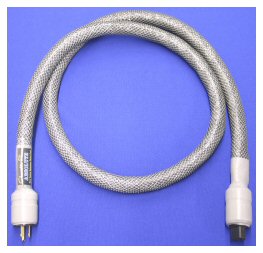 After plugging the Absolutes into the system it was obvious that Mr. Lee’s top of the line power cords sounded better than the Gargantua IIs, but it was only after I had played them in the system a number of hours that the cables began to demonstrate some superb qualities. As a member of the Acoustic Zen family the Absolute power cords exhibited that familiar trait that is synonymous with Mr. Lee’s cables: extremely detailed sound with great extension and solid bass. But the first thing that was striking was that the music seemed much louder with the Absolutes installed than with the Gargantua IIs. I noticed it immediately because the Bel Canto Pre3 preamp employs a digital display and the volume level remained unchanged. Still, it was quite easy to discern that the music seemed louder and thus more life-like. For me, the benefit to having louder and less constrained music is it is easier to hear sounds that emanate from the background. Not only is it easier to hear little nuances from the back of the stage but the musicians have a more realistic stage presence. As you read further you’ll find out what I am talking about. And that isn’t just true for the power cords, it’s prevalent throughout the Absolute line.
After plugging the Absolutes into the system it was obvious that Mr. Lee’s top of the line power cords sounded better than the Gargantua IIs, but it was only after I had played them in the system a number of hours that the cables began to demonstrate some superb qualities. As a member of the Acoustic Zen family the Absolute power cords exhibited that familiar trait that is synonymous with Mr. Lee’s cables: extremely detailed sound with great extension and solid bass. But the first thing that was striking was that the music seemed much louder with the Absolutes installed than with the Gargantua IIs. I noticed it immediately because the Bel Canto Pre3 preamp employs a digital display and the volume level remained unchanged. Still, it was quite easy to discern that the music seemed louder and thus more life-like. For me, the benefit to having louder and less constrained music is it is easier to hear sounds that emanate from the background. Not only is it easier to hear little nuances from the back of the stage but the musicians have a more realistic stage presence. As you read further you’ll find out what I am talking about. And that isn’t just true for the power cords, it’s prevalent throughout the Absolute line.
One of my tests of how well a system recreates the musical experience is how well ordinary red book CDs and vinyl records purchased from places like Wal-Mart, Amazon, or my local record store sounds on my system. I know that most audiophiles only have top quality recordings in their collections and would never consider anything that is in the bargain rack (just kidding). But whenever I can find some good music at great prices I’ll generally add them to my collection. Courtesy of a Tower Records liquidation sale, I did just that and picked up a CD for less than three dollars. The name of the disc is This is Billy Mitchell [Smash Records SRS 67027]. The first track, “J&B” let’s you know right away that this is a major talent. Mitchell might not be a household name but the man can really play the tenor sax. With the Absolute power cords installed, the soundstage expanded significantly.
Besides the soundstage improvements the Absolute power cords also add more presence and body to the performers. With Billy Mitchell playing tenor sax, the presentation was much more personal and it seemed as though I was listening to the performance from just a couple chairs away in the studio as opposed to from afar. The notes from his horn also seemed to come from an exact spot in the soundstage and I could almost imagine music coming out the bell of his horn. Otis Finch on drums helps to maintain the pace and with the Absolutes I was able to enjoy the cymbal work from this early 1960’s recording without any unwanted sizzle or hardness (usually associated with these excellent but otherwise dated recordings). Because the drummer was much closer in proximity to the other musicians it seemed like he was an integral part of the group and not way off in the background, an effect which helped the presentation sound more realistic due to better integration.
The Speaker Cables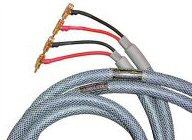 Taking a cursory look at the Absolute speaker cables I noticed, once again, that there was a family resemblance. Although similar in appearance I was able to distinguish one from the other because the outer sheath of the Absolutes has the silver reflectors with grey shrink wrap and the Hologram II’s have gold reflectors with purple shrink wrap. Even though externally the two speaker cables are somewhat similar in looks, internally it is another story because the materials used for the construction of the two cables is completely different. The Hologram II speaker cables are made of 100 percent copper and the Absolute speaker cables are made from a seven nines silver and copper hybrid. I tried to get the exact percentages from Mr. Lee but because of trade secrets, he would reveal only that each one of the precious metals is used in the construction of the Absolute speaker cables. The ends can be terminated with either spades or banana plugs but the demo cables I received contained some nice gold plated heavy spades. I was already impressed with the performance of Mr. Lee’s power cords and although I was expecting some stellar results from the speaker cables, what I experienced was inspiring to say the least.
Taking a cursory look at the Absolute speaker cables I noticed, once again, that there was a family resemblance. Although similar in appearance I was able to distinguish one from the other because the outer sheath of the Absolutes has the silver reflectors with grey shrink wrap and the Hologram II’s have gold reflectors with purple shrink wrap. Even though externally the two speaker cables are somewhat similar in looks, internally it is another story because the materials used for the construction of the two cables is completely different. The Hologram II speaker cables are made of 100 percent copper and the Absolute speaker cables are made from a seven nines silver and copper hybrid. I tried to get the exact percentages from Mr. Lee but because of trade secrets, he would reveal only that each one of the precious metals is used in the construction of the Absolute speaker cables. The ends can be terminated with either spades or banana plugs but the demo cables I received contained some nice gold plated heavy spades. I was already impressed with the performance of Mr. Lee’s power cords and although I was expecting some stellar results from the speaker cables, what I experienced was inspiring to say the least.
After I swapped out the Hologram II’s for the Absolutes I knew why Mr. Lee’s top of the line speaker cables costs nearly twice as much as the Holograms. The sound was simply spectacular and excelled from top to bottom. In describing the effect of the Absolute loudspeaker cables the word “transformer” comes to mind (and I don’t mean the ones that look like a Ford Escort one minute and then turn into a 30 foot tall killer robot the next). From the moment I installed the Absolute cables into the system I was presented with all kinds of wonderful musical colors that seemed to take an already well lit room and fill it with the warm and natural rays of a rising sunshine. With the Absolute speaker cables plugged into the system more content and emotionalism was revealed. Music played through the Absolutes had that extra bit of body in the lower registers so that you can feel the movement and the pace of the recordings. Instead of the music coming at me in a straight line the performers seemed to present themselves in a circular fashion. Quite frankly, the sound coming from my loudspeakers had more soul and emphasis.
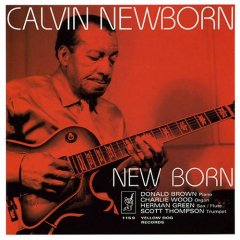 One of my favorite recordings (which I feel can reflect the inner working of a man’s soul) is Calvin Newborn’s New Born[Yellow Dog Records 1159]. This is a hearty blues piece that was recently released. There a number of tracks I like on this CD, but taking me down blues alley is selection number seven, “After Hour Blues.” This track is eight minutes and seventeen seconds of music that reminds me of when performers from the late fifties and early sixties got an opportunity to improvise and play from the heart. Just like with the Absolute power cords, the sound with the speaker cables in the system is louder and the music is much fuller. Each of the performers is highlighted as though a collective spotlight is cast on all, especially the drummer. Compared to the Hologram II’s, drummer Renardo Ward came from being further in the background to being better integrated into the soundstage, allowing me to hear greater dynamics and intensity. The drums had an abundance of sparkle and just like at a real event the sound of the cymbals seemed to enter the room unobstructed through the air. The organ had more of that circular grovel that is equivalent to reaching down to sing from one’s belly instead of from the throat. Calvin Newborn knows how to make the guitar sing and instead of concentrating on each note I was able to enjoy the performance as though his play is a means to an end. The Absolute cables allowed me to get a clearer perspective of the performance by giving me access to the front row and looking into the stage instead of sitting five or so rows away at a distance which ultimately presented a declarative, rich, and awarding performance.
One of my favorite recordings (which I feel can reflect the inner working of a man’s soul) is Calvin Newborn’s New Born[Yellow Dog Records 1159]. This is a hearty blues piece that was recently released. There a number of tracks I like on this CD, but taking me down blues alley is selection number seven, “After Hour Blues.” This track is eight minutes and seventeen seconds of music that reminds me of when performers from the late fifties and early sixties got an opportunity to improvise and play from the heart. Just like with the Absolute power cords, the sound with the speaker cables in the system is louder and the music is much fuller. Each of the performers is highlighted as though a collective spotlight is cast on all, especially the drummer. Compared to the Hologram II’s, drummer Renardo Ward came from being further in the background to being better integrated into the soundstage, allowing me to hear greater dynamics and intensity. The drums had an abundance of sparkle and just like at a real event the sound of the cymbals seemed to enter the room unobstructed through the air. The organ had more of that circular grovel that is equivalent to reaching down to sing from one’s belly instead of from the throat. Calvin Newborn knows how to make the guitar sing and instead of concentrating on each note I was able to enjoy the performance as though his play is a means to an end. The Absolute cables allowed me to get a clearer perspective of the performance by giving me access to the front row and looking into the stage instead of sitting five or so rows away at a distance which ultimately presented a declarative, rich, and awarding performance.
The Interconnects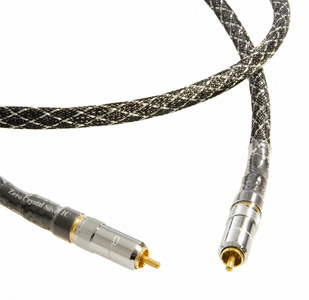 Appearance-wise the Absolute interconnects definitely look different from the Silver Reference II’s. It is also fairly easy to tell the difference between the two designs simply by touch. The Silver Ref II has an outer grey Teflon covering that is somewhat stiff but not so stiff that you can’t bend it, work with it, or end up getting frustrated while trying to install the interconnects between components. The Absolute interconnect has a black Teflon covering with silver accents and is extremely flexible and light in weight compared to the Silver Reference II’s. The Silver Reference II is composed of 97% seven nines silver and 3% copper. The Absolute is made from silver too; 99% silver and 1% copper. According to Mr. Lee even the addition of a small amount of copper will smooth out the sound. The Absolutes can be terminated with custom designed RCAs or Neutrik brand XLR’s.
Appearance-wise the Absolute interconnects definitely look different from the Silver Reference II’s. It is also fairly easy to tell the difference between the two designs simply by touch. The Silver Ref II has an outer grey Teflon covering that is somewhat stiff but not so stiff that you can’t bend it, work with it, or end up getting frustrated while trying to install the interconnects between components. The Absolute interconnect has a black Teflon covering with silver accents and is extremely flexible and light in weight compared to the Silver Reference II’s. The Silver Reference II is composed of 97% seven nines silver and 3% copper. The Absolute is made from silver too; 99% silver and 1% copper. According to Mr. Lee even the addition of a small amount of copper will smooth out the sound. The Absolutes can be terminated with custom designed RCAs or Neutrik brand XLR’s.
Initially, I started listening to the system with the Absolute interconnects that were terminated with RCAs but since I’m using a balanced preamp and amplifier I switched to the XLR cables.
One of the complaints that is sometimes made about cables that are made from silver is that the sonic signature leans toward brightness and sometimes can have a softening effect on the lower bass. With the Absolutes the tonal balance is centered toward neutral with plenty of detail, low end authority, and a naturalness that can be associated with cables that are made from copper. Silver is known to exhibit extreme speed with exceptional attack and the Absolutes excel in this area.
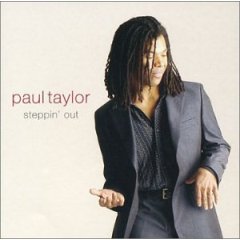 Another of the Absolute’s strengths is the way they get out of the way and allow performers to communicate the music. This is undeniably evident from the very first note of my listening sessions to the last. There is a synergy amongst the musicians that I found uncanny. Paul Taylor and crew on Steppin’ Out[Peak Records PKD-8516-2] appeared to be locked in, focused, everything just right as though they had been playing together for years – – similar to when I hear live jazz musicians come to town and pick up a drummer or guitarist and perform as though they’ve been rehearsing continuously.
Another of the Absolute’s strengths is the way they get out of the way and allow performers to communicate the music. This is undeniably evident from the very first note of my listening sessions to the last. There is a synergy amongst the musicians that I found uncanny. Paul Taylor and crew on Steppin’ Out[Peak Records PKD-8516-2] appeared to be locked in, focused, everything just right as though they had been playing together for years – – similar to when I hear live jazz musicians come to town and pick up a drummer or guitarist and perform as though they’ve been rehearsing continuously.
The Absolute interconnects exhibited the same virtuous qualities on vocals and instrumentals. On track four, “Someone Watching Over Me,” lead vocalist Sharon Youngblood sings about keeping the faith. With the Absolutes it is like listening to a performer who has perfected her craft with the correct annunciation but is also experienced enough to know that there is more to singing than just getting the notes right. Each note took on a rounded shape and emerged from the stage with a rich, sultry sound that was devoid of coloration. Hearing her sing, I experienced an emotional connection that easily helped me understand the purpose behind this song.
The Absolute End
Both individually and collectively the Absolute line of cables delivered a musical presentation that is significantly better than Mr. Lee’s previous top of the line cables. The sound that permeated throughout my room exhibited the traditional characteristics of Acoustic Zen cables: light, airy, and detailed treble, excellent retrieval of low level information, and tight bass with excellent definition, clarity and focus. The soundstage presentation was so up close and personal with incredible impact such that every time I listened to a disc I was whisked away to musical paradise. The fact that the Absolute cables are more than twice the price of some of the components in my system is not that much of a surprise based on the elevated level of performance and their ability to get the listener more intimately involved with the presentation.
Listening to music via the Absolutes is more than just musically satisfying – it’s musically persuasive; convincing enough that as an audiophile you could easily utilize these outstanding cables in your reference system and sit in your favorite recliner for hours on end, rediscovering old discs and having a good time with new ones, just as I did. Each time I inserted one of the Absolute cables into the system, especially the speaker cables and balanced interconnects; the presentation became much more vibrant and encompassing.
Embarking on an upgrade path, while expensive, is definitely worth it. I would start with the loudspeaker cables because there is where I heard a dramatic change in the quality of performance at the least amount of cost, followed by the interconnects and finally the power cords.
According to Webster’s dictionary the word “Absolute” means free of any restriction, limitation, or exception. Since I don’t have any sophisticated electronic measuring equipment I cannot scientifically verify their measurement specs. But sonically Mr. Lee’s cables are an exceptional product that surpassed my wildest expectations.
The addition of the Acoustic Zen Absolute cables to my system has been a refreshing musical tonic that satisfied my desire for the very best cables available. So does that mean that they are now my new reference? Absolutely! Without a doubt these are some of the best cables that I’ve heard and certainly deserving of our “Most Wanted Component” recognition.

________________________
Manufacturer:
Acoustic Zen
16736 West Bernardo Drive
San Diego, Ca. 92127
Tel: 858-487-1988
Website: www.acousticzen.com
Price: Absolute Power Cords $2488.00 for 6 feet. Plus $260/ft for longer lengths, minus $130/ft for shorter lengths
Price: Absolute Speaker Cables $2880.00 for mono 8 feet. Plus $260/ft for longer lengths, minus $130/ft for shorter lengths
Price: Absolute Interconnect $2488.00 1.0 meter with RCA, $2488.00 1.0 meter with XLR. Plus $260/ft for longer lengths, minus $130/ft for shorter lengths
U.S. Distributor and Director of Worldwide Product:
FLK Marketing and Distribution
Frank L. Kraus, President
Post Office Box 1247
Pine Hill, New Jersey 08021
Tel: 856-374-4757 Office
Email: FLKraus@netzero.net
![]()
Don’t forget to bookmark us! (CTRL-SHFT-D)
Stereo Times Masthead
Publisher/Founder
Clement Perry
Editor
Dave Thomas
Senior Editors
Frank Alles, Mike Girardi, Key Kim, Russell Lichter, Terry London, Moreno Mitchell, Paul Szabady, Bill Wells, Mike Wright, Stephen Yan, and Rob Dockery
Current Contributors
David Abramson, Tim Barrall, Dave Allison, Ron Cook, Lewis Dardick, Dan Secula, Don Shaulis, Greg Simmons, Eric Teh, Greg Voth, Richard Willie, Ed Van Winkle, and Rob Dockery
Music Reviewers:
Carlos Sanchez, John Jonczyk, John Sprung and Russell Lichter
Site Management Clement Perry
Ad Designer: Martin Perry





Be the first to comment on: Acoustic Zen Absolute Cables